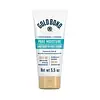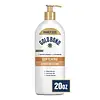What's inside
What's inside
 Key Ingredients
Key Ingredients

 Benefits
Benefits

 Concerns
Concerns

 Ingredients Side-by-side
Ingredients Side-by-side

Water
Skin ConditioningHydroxyethyl Urea
HumectantCaprylic/Capric Triglyceride
MaskingDimethicone
EmollientGlycerin
HumectantStearyl Alcohol
EmollientVitis Vinifera Seed Oil
EmollientGlyceryl Stearate
EmollientSodium Hyaluronate
HumectantCeramide NP
Skin ConditioningGluconolactone
Skin ConditioningSteareth-21
CleansingNiacinamide
SmoothingGuar Hydroxypropyltrimonium Chloride
Skin ConditioningCholesterol
EmollientCeramide Ns
Skin ConditioningPolysorbate 60
EmulsifyingEthylhexylglycerin
Skin ConditioningPanthenol
Skin ConditioningCeramide EOP
Skin ConditioningCaprooyl Phytosphingosine
Skin ConditioningPolyacrylate Crosspolymer-6
Emulsion StabilisingCeramide Eos
Skin ConditioningHydroxyacetophenone
AntioxidantCetyl Alcohol
EmollientCeramide AP
Skin ConditioningCaprooyl Sphingosine
Skin ConditioningTocopherol
AntioxidantCetearyl Alcohol
EmollientDisodium EDTA
Ceteareth-25
Cleansing3-O-Ethyl Ascorbic Acid
Skin ConditioningBehenic Acid
CleansingWater, Hydroxyethyl Urea, Caprylic/Capric Triglyceride, Dimethicone, Glycerin, Stearyl Alcohol, Vitis Vinifera Seed Oil, Glyceryl Stearate, Sodium Hyaluronate, Ceramide NP, Gluconolactone, Steareth-21, Niacinamide, Guar Hydroxypropyltrimonium Chloride, Cholesterol, Ceramide Ns, Polysorbate 60, Ethylhexylglycerin, Panthenol, Ceramide EOP, Caprooyl Phytosphingosine, Polyacrylate Crosspolymer-6, Ceramide Eos, Hydroxyacetophenone, Cetyl Alcohol, Ceramide AP, Caprooyl Sphingosine, Tocopherol, Cetearyl Alcohol, Disodium EDTA, Ceteareth-25, 3-O-Ethyl Ascorbic Acid, Behenic Acid
Water
Skin ConditioningGlycerin
HumectantHydroxyethyl Urea
HumectantDimethicone
EmollientCocos Nucifera Oil
MaskingJojoba Esters
EmollientPetrolatum
EmollientSteareth-21
CleansingCetyl Alcohol
EmollientDistearyldimonium Chloride
Aloe Barbadensis Leaf Juice
Skin ConditioningStearyl Alcohol
EmollientCyclopentasiloxane
EmollientCetearyl Alcohol
EmollientBehentrimonium Methosulfate
Butyrospermum Parkii Butter Extract
Skin ConditioningGlyceryl Stearate
EmollientMethyl Gluceth-20
HumectantTheobroma Cacao Seed Butter
EmollientSilk Amino Acids
HumectantPanthenol
Skin ConditioningCeramide Ng
Skin ConditioningChamomilla Recutita Flower Extract
MaskingMagnesium Ascorbyl Phosphate
AntioxidantTocopheryl Acetate
AntioxidantRetinyl Palmitate
Skin ConditioningHydrolyzed Jojoba Esters
Skin ConditioningPalmitoyl Hexapeptide-12
Skin ConditioningLavandula Angustifolia Extract
Skin ConditioningAcacia Farnesiana Flower Extract
PerfumingEthylhexylglycerin
Skin ConditioningPEG-10 Phytosterol
EmulsifyingButylene Glycol
HumectantDimethiconol
EmollientC12-15 Alkyl Benzoate
AntimicrobialPropylene Glycol
HumectantStearamidopropyl Pg-Dimonium Chloride Phosphate
Polysorbate 60
EmulsifyingEDTA
Methylparaben
PreservativeParfum
MaskingPotassium Hydroxide
BufferingRosmarinus Officinalis Leaf Extract
AntimicrobialIsopropyl Myristate
EmollientTribehenin
EmollientWater, Glycerin, Hydroxyethyl Urea, Dimethicone, Cocos Nucifera Oil, Jojoba Esters, Petrolatum, Steareth-21, Cetyl Alcohol, Distearyldimonium Chloride, Aloe Barbadensis Leaf Juice, Stearyl Alcohol, Cyclopentasiloxane, Cetearyl Alcohol, Behentrimonium Methosulfate, Butyrospermum Parkii Butter Extract, Glyceryl Stearate, Methyl Gluceth-20, Theobroma Cacao Seed Butter, Silk Amino Acids, Panthenol, Ceramide Ng, Chamomilla Recutita Flower Extract, Magnesium Ascorbyl Phosphate, Tocopheryl Acetate, Retinyl Palmitate, Hydrolyzed Jojoba Esters, Palmitoyl Hexapeptide-12, Lavandula Angustifolia Extract, Acacia Farnesiana Flower Extract, Ethylhexylglycerin, PEG-10 Phytosterol, Butylene Glycol, Dimethiconol, C12-15 Alkyl Benzoate, Propylene Glycol, Stearamidopropyl Pg-Dimonium Chloride Phosphate, Polysorbate 60, EDTA, Methylparaben, Parfum, Potassium Hydroxide, Rosmarinus Officinalis Leaf Extract, Isopropyl Myristate, Tribehenin
 Reviews
Reviews

Ingredients Explained
These ingredients are found in both products.
Ingredients higher up in an ingredient list are typically present in a larger amount.
Cetearyl alcohol is a mixture of two fatty alcohols: cetyl alcohol and stearyl alcohol. It is mainly used as an emulsifier. Emulsifiers help prevent the separation of oils and products. Due to its composition, it can also be used to thicken a product or help create foam.
Cetearyl alcohol is an emollient. Emollients help soothe and hydrate the skin by trapping moisture.
Studies show Cetearyl alcohol is non-toxic and non-irritating. The FDA allows products labeled "alcohol-free" to have fatty alcohols.
This ingredient is usually derived from plant oils such as palm, vegetable, or coconut oils. There is debate on whether this ingredient will cause acne.
Due to the fatty acid base, this ingredient may not be Malassezia folliculitis safe.
Learn more about Cetearyl AlcoholCetyl Alcohol is a fatty alcohol. Fatty Alcohols are most often used as an emollient or to thicken a product.
Its main roles are:
Though it has "alcohol" in the name, it is not related to denatured alcohol or ethyl alcohol.
The FDA allows products labeled "alcohol-free" to have fatty alcohols.
Learn more about Cetyl AlcoholDimethicone is a type of synthetic silicone created from natural materials such as quartz.
What it does:
Dimethicone comes in different viscosities:
Depending on the viscosity, dimethicone has different properties.
Ingredients lists don't always show which type is used, so we recommend reaching out to the brand if you have questions about the viscosity.
This ingredient is unlikely to cause irritation because it does not get absorbed into skin. However, people with silicone allergies should be careful about using this ingredient.
Note: Dimethicone may contribute to pilling. This is because it is not oil or water soluble, so pilling may occur when layered with products. When mixed with heavy oils in a formula, the outcome is also quite greasy.
Learn more about DimethiconeEthylhexylglycerin (we can't pronounce this either) is commonly used as a preservative and skin softener. It is derived from glyceryl.
You might see Ethylhexylglycerin often paired with other preservatives such as phenoxyethanol. Ethylhexylglycerin has been found to increase the effectiveness of these other preservatives.
Glycerin is already naturally found in your skin. It helps moisturize and protect your skin.
A study from 2016 found glycerin to be more effective as a humectant than AHAs and hyaluronic acid.
As a humectant, it helps the skin stay hydrated by pulling moisture to your skin. The low molecular weight of glycerin allows it to pull moisture into the deeper layers of your skin.
Hydrated skin improves your skin barrier; Your skin barrier helps protect against irritants and bacteria.
Glycerin has also been found to have antimicrobial and antiviral properties. Due to these properties, glycerin is often used in wound and burn treatments.
In cosmetics, glycerin is usually derived from plants such as soybean or palm. However, it can also be sourced from animals, such as tallow or animal fat.
This ingredient is organic, colorless, odorless, and non-toxic.
Glycerin is the name for this ingredient in American English. British English uses Glycerol/Glycerine.
Learn more about GlycerinGlyceryl Stearate is a mix of glycerin and stearic acid.
It is used to stabilize the mixing of water and oil ingredients. By preventing these ingredients from separating, it can help elongate shelf life. It can also help thicken the product's texture.
As an emollient, it helps soften skin and supports barrier-replenishing ingredients.
In cosmetics, Glyceryl Stearate is often made from vegetable oils or synthetically produced.
This ingredient may not be fungal-acne safe
Fun fact: The human body also creates Glyceryl Stearate naturally.
Learn more about Glyceryl StearatePanthenol is a common ingredient that helps hydrate and soothe the skin. It is found naturally in our skin and hair.
There are two forms of panthenol: D and L.
D-panthenol is also known as dexpanthenol. Most cosmetics use dexpanthenol or a mixture of D and L-panthenol.
Panthenol is famous due to its ability to go deeper into the skin's layers. Using this ingredient has numerous pros (and no cons):
Like hyaluronic acid, panthenol is a humectant. Humectants are able to bind and hold large amounts of water to keep skin hydrated.
This ingredient works well for wound healing. It works by increasing tissue in the wound and helps close open wounds.
Once oxidized, panthenol converts to pantothenic acid. Panthothenic acid is found in all living cells.
This ingredient is also referred to as pro-vitamin B5.
Learn more about PanthenolPolysorbate 60 is used to help stabilize products. It is a surfactant and emulsifier. These properties help keep ingredients together in a product. Surfactants help reduce surface tension between ingredients with different states, such as liquids and solids. Emulsifiers help prevent oils and waters from separating.
Polysorbate 60 is sorbitol-based and created from the ethoxylation of sorbitan. Ethoxylation is a chemical reaction used to add ethylene oxide. Sorbitan is a the dehydrated version of sorbitol, a sugar found in fruits.
In this case, the 60 comes from reacting 60 units of ethylene oxide with sorbitan.
Polysorbates are commonly used in medicine and foods.
Learn more about Polysorbate 60We don't have a description for Steareth-21 yet.
Stearyl Alcohol is a type of fatty alcohol from stearic acid. It is a white, waxy compound used to emulsify ingredients.
Fatty Alcohols are most often used as an emollient or to thicken a product. Emollients help soothe and hydrate the skin by trapping moisture.
They are usually derived from natural fats and oils and therefore do not have the same drying or irritating effect as solvent alcohols. FDA allows products labeled "alcohol-free" to have fatty alcohols.
Learn more about Stearyl AlcoholWater. It's the most common cosmetic ingredient of all. You'll usually see it at the top of ingredient lists, meaning that it makes up the largest part of the product.
So why is it so popular? Water most often acts as a solvent - this means that it helps dissolve other ingredients into the formulation.
You'll also recognize water as that liquid we all need to stay alive. If you see this, drink a glass of water. Stay hydrated!
Learn more about Water